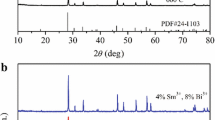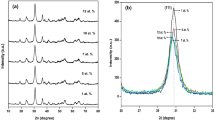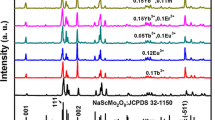Abstract
A novel attempt towards the synthesis of red-emitting europium (\(\hbox {Eu}^{3+}\))-doped \(\hbox {CaSrSiO}_{4}\) phosphors has been made through a templated strategy using non-ionic surfactant as template. The concentrations of \(\hbox {Eu}^{3+}\) in the host were altered and the optimized concentration to extract the maximum efficacy was analysed. The crystalline structure and morphologies of the synthesized phosphor were studied and analysed. The results show the aggregated rod-like morphology with a continuous porous network that shows the maximum intensity at 10 mol% of dopant.
Similar content being viewed by others
Explore related subjects
Discover the latest articles, news and stories from top researchers in related subjects.Avoid common mistakes on your manuscript.
1 Introduction
Phosphors have played a vital role in luminosity of white light-emitting diode (LED). The conventional methods to get white light are RBG method and phosphor method. The RGB method involves using separate chips for generating red, green and blue light; hence this method is complicated and expensive in constructing devices [1]. The phosphor method uses a process to get white photons by integrating InGaN LED chip with yellow-emitting \(\hbox {Y}_{3}\hbox {A}_{\mathrm{l}5}\hbox {O}_{12}\,{:}\,\hbox {Ce}^{3+}\) (\(\hbox {YAG}\,{:}\,\hbox {Ce}^{3+})\) phosphor. By this method, cool white light is produced by measly red emission components in a yellow phosphor [2,3,4]. Overcoming these issues, warm white light can be produced using a single emitting centre with yellow phosphor possessing high colour rendering index and low correlated colour temperature.
Because of marvellous luminescence properties, rare earth elements have played a significant role in modern lighting. High colour purity can be achieved by f–f electronic transition of rare earth ions [6,7,8]. As an important member of the rare earth ions, trivalent europium ion (\(\hbox {Eu}^{3+})\) is an excellent red-emitting activating agent as a result of \(^{5}\hbox {D}_{0}{-}^{7}\hbox {F}_{J}\) (\(J=0,1,2,3,4\)) [9]. \(\hbox {Eu}^{3+}\)-doped red-emitting oxide phosphors are easy to prepare, nature friendly and show strong absorption in the region of 400–300 nm; powerful energy transfer takes place from the host matrix to \(\hbox {Eu}^{3+}\) [10, 11]. Sulphide, nitride and aluminate host matrix silicate are easy to prepare, inexpensive and nature friendly [12,13,14]. Works have been reported on \(\hbox {CaSrSiO}_{4}\,{:}\,\hbox {Eu}^{2+}\), \(\hbox {CaSiO}_{3}\,{:}\,\hbox {Eu}^{3+}\) and \(\hbox {Ca}_{3}\hbox {Si}_{2}\hbox {O}_{7}\,{:}\,\hbox {Eu}^{2+}\).
In this article, we report a novel endeavour towards the development of \(\hbox {Eu}^{3+}\)-doped \(\hbox {CaSrSiO}_{4}\) using silica nanoparticles. \(\hbox {CaSrSiO}_{4}\) phosphor, with a single \(\hbox {Eu}^{3+}\) emitting centre that achieves \(\hbox {CCT}\,{<}4000\) K and \(\hbox {CRI}\,{>}80\), was obtained at a temperature of \(1000{^{\circ }}\hbox {C}\) by a hydrothermal method. The newly synthesized \(\hbox {Eu}^{3+}\)-doped \(\hbox {CaSrSiO}_{4}\) phosphors exhibit a good thermal luminescence stability and high quantum efficiency.
2 Materials and methods
2.1 Materials
Poly(ethylene oxide)–poly(propylene oxide)–poly(ethylene oxide) tri-block copolymer (P-123) and europium chloride hexahydrate (\(\hbox {EuCl}_{3}{\cdot }6\hbox {H}_{2}\hbox {O}\)) were purchased from Sigma-Aldrich. Strontium chloride hexahydrate (\(\hbox {SrCl}_{2}{\cdot }6\hbox {H}_{2}\hbox {O}\)), calcium chloride dihydrate (\(\hbox {CaCl}_{2}{\cdot }2\hbox {H}_{2}\hbox {O}\)), tetraethyl ortho silane (TEOS), hydrochloric acid (HCl) and solvents were purchased from Avra. The afore-mentioned chemicals were used without any further purification.
2.2 Methods
2.2.1 Synthesis of \(\hbox {Ca}_{1-x}\hbox {Sr}_{1-x}\hbox {Eu}^{3+}_{2x}\hbox {SiO}_{4}\) phosphor
In order to synthesize \(\hbox {Ca}_{1-x}\hbox {Sr}_{1-x}\hbox {Eu}^{3+}_{2x}\hbox {SiO}_{4}\) phosphor through templated synthetic strategy, initially 1.23 g of P-123 was taken in 10 ml of methanol and 40 ml of 2 N HCl. The organic precursor of silica (TEOS) was added, which was followed by the addition of other cationic precursors such as \(\hbox {SrCl}_{2}{\cdot }6\hbox {H}_{2}\hbox {O}\), \(\hbox {CaCl}_{2}{\cdot }2\hbox {H}_{2}\hbox {O}\) and \(\hbox {EuCl}_{3}{\cdot }6\hbox {H}_{2}\hbox {O}\). The solution was stirred at room temperature till a homogeneous solution was obtained and it was kept for ageing process at \(80{^{\circ }}\hbox {C}\) for 6 h in a Teflon flask. The precipitate was then dried at \(100{^{\circ }}\hbox {C}\) overnight and sintered at \(1000{^{\circ }}\hbox {C}\) for 4 h in order to remove the template as well as to get the final phosphor. The chemical ratio of \(\hbox {Sr}^{2+}\,{:}\,\hbox {Ca}^{2+}\,{:}\,\hbox {TEOS}\,{:}\,\hbox {Eu}^{3+}\) was maintained as \(1-x\,{:}\,1-x\,{:}\,1\,{:}\,2x\) (\(2x=1, 5, 10\) and 15 mol%).
2.2.2 Characterization techniques
The crystalline structure of synthesized \(\hbox {Ca}_{1-x}\hbox {Sr}_{1-x}\hbox {Eu}^{3+}_{2x}\hbox {SiO}_{4}\) phosphor was studied using a powder X-ray diffractometer (XRD) between \(20{^{\circ }}\) and \(80{^{\circ }}\) \((2\theta )\) at a scan speed of \(0.01{^{\circ }}\) per step and 1 s per step (XRD, D8 focus, Bruker, Germany). The surface and internal morphology of \(\hbox {Ca}_{1-x}\hbox {Sr}_{1-x}\hbox {Eu}^{3+}_{2x}\hbox {SiO}_{4}\) phosphors were imaged using a field emission scanning electron microscope (FE-SEM, Tescan, MIRA, Czech Republic) and a field emission transmission electron microscope (FE-TEM, JEM 2100F, JEOL, Japan) with an operating voltage of 20 and 200 kV, respectively. The photoluminescence (PL) excitation and emission behaviours of \(\hbox {Ca}_{1-x}\hbox {Sr}_{1-x}\hbox {Eu}^{3+}_{2x}\hbox {SiO}_{4}\) (\(2x=1, 5, 10\) and 15 mol%) phosphors were thoroughly studied using a PL spectrometer (FP-8500, Jasco, Japan) with a Xe lamp as the excitation source.
3 Results and discussion
3.1 Crystallinity behaviour of \(\hbox {Ca}_{1-x}\hbox {Sr}_{1-x}\hbox {Eu}^{3+}_{2x}\hbox {SiO}_{4}\) phosphor
The phosphor samples have been synthesized through templated technique using P-123 as a structure-directing agent with different \(\hbox {Eu}^{3+}\) concentrations (1–15 mol%). Initially the synthesized phosphors were analysed for their crystal structure. Figure 1 shows the powder XRD patterns of undoped \(\hbox {CaSrSiO}_{4}\) and \(\hbox {Ca}_{0.95}\hbox {Sr}_{0.95}\hbox {Eu}^{3+}_{0.1}\hbox {SiO}_{4}\) along with the reference pattern of \(\hbox {CaSrSiO}_{4}\) (JCPDS No. 77-1619). The result shows the perfect match of undoped and 10-mol%-\(\hbox {Eu}^{3+}\)-introduced \(\hbox {CaSrSiO}_{4}\) with the pure \(\hbox {CaSrSiO}_{4}\) phase, which confirms that the introduction of 10 mol% of dopant has not collapsed the crystal phase of \(\hbox {CaSrSiO}_{4}\). The crystallite sizes of the undoped and doped \(\hbox {CaSrSiO}_{4}\) were calculated using the Scherrer formula and found to be 18.15 and 19.04 nm, respectively. The ionic radii of cations \(\hbox {Ca}^{2+}\) and \(\hbox {Sr}^{2+}\) in the host lattice \(\hbox {CaSrSiO}_{4}\) are 0.099 and 0.118 nm, respectively. Hence, the dopant \(\hbox {Eu}^{3+}\) with ionic radius of 0.095 nm can replace the \(\hbox {Ca}^{2+}\), which has a similar ionic radius, or the bigger ion \(\hbox {Sr}^{2+}\) rarely. Hence, the XRD pattern proves that there is no change in the crystal phase of host lattice.
3.2 Morphological studies
The morphological studies of \(\hbox {Ca}_{0.95}\hbox {Sr}_{0.95}\hbox {Eu}^{3+}_{0.1}\hbox {SiO}_{4}\) phosphors synthesized using P-123 as template have been performed using a SEM and a TEM. The surface morphologies are shown in figure 2A and B, whereas the internal morphologies can be seen in figure 2C and D, which are imaged using the SEM and TEM, respectively. The results show the morphology of around 1-\(\upmu \hbox {m}\)-sized aggregated rods with nanoporous structure due to the use of template P-123 during synthesis. Initially, P-123 makes spherical micelles when it reaches the CMC (critical micellar concentration), which get aggregated to one another to form a rod-like structure. The introduced cations (\(\hbox {Sr}^{2+}\), \(\hbox {Ca}^{2+}\) and \(\hbox {Eu}^{3+})\) and silica precursor (TEOS) interact on the surface of aggregated rod-structured micelles. The interaction leads to the hydrolysis of all the cations on the surface of micelles, which will be dried and calcined later. The porosity in the phosphor is formed due to the removal of template during the calcination process at high temperature. TEM images also confirm the aggregated rod structure of \(\hbox {Ca}_{0.95}\hbox {Sr}_{0.95}\hbox {Eu}^{3+}_{0.1}\hbox {SiO}_{4}\), whereas the fine local structures of the same phosphor are verified using a high-resolution (HR) image. It shows the continuous lattice fringes without any defects, which further confirm the high crystallinity nature of \(\hbox {Ca}_{0.95}\hbox {Sr}_{0.95}\hbox {Eu}^{3+}_{0.1}\hbox {SiO}_{4}\) phosphor. The d spacing of the phosphor was also calculated using the HR image, which was found to be 0.431 nm. Figure 2E shows the selected area electron diffraction pattern (SAED) of \(\hbox {Ca}_{0.95}\hbox {Sr}_{0.95}\hbox {Eu}^{3+}_{0.1}\hbox {SiO}_{4}\) phosphor, which confirms that the introduction of dopant has not collapsed the crystal structure of the host \(\hbox {CaSrSiO}_{4}\).
3.3 PL studies
The PL behaviours of synthesized \(\hbox {Ca}_{1-x}\hbox {Sr}_{1-x}\hbox {Eu}^{3+}_{2x}\hbox {SiO}_{4}\) (\(2x=1, 5, 10\) and 15 mol%) phosphors have been analysed by PL spectroscopy and presented in figure 3. Initially the excitation was recorded at 615 nm of emission, which corresponds to the \(^{5}\hbox {D}_{0}-^{7}\hbox {F}_{2}\) transition of \(\hbox {Eu}^{3+}\). There are sharp peaks obtained between 300 and 500 nm along with a broad band at 250 nm wavelength. The broad band in ultraviolet (UV) region peaking at 250 nm is observed due to the well-known charge transfer band (CTB), which arises by electron transfer from oxygen 2p state to 4f state of \(\hbox {Eu}^{3+}\) \((\hbox {O}^{2-}{-}\hbox {Eu}^{3+})\). There are several other sharp peaks registered at various wavelengths such as 360, 388, 395, 419 and 460 nm, which can be well correlated to the 4f–4f transitions of \(\hbox {Eu}^{3+}\) (\(^{7}\hbox {F}_{0}{-}^{5}\hbox {D}_{4})\), (\(^{7}\hbox {F}_{0}{-}^{5}\hbox {L}_{7})\), (\(^{7}\hbox {F}_{0}{-}^{5}\hbox {L}_{6})\), (\(^{7}\hbox {F}_{0}{-}^{5}\hbox {D}_{3})\) and (\(^{7}\hbox {F}_{0}{-}^{5}\hbox {D}_{2})\), respectively. The maximum intensity is recorded for the transition from \(^{7}\hbox {F}_{0}\) to \(^{5}\hbox {L}_{6}\) at 395 nm, while the intensities of other peaks are distributed in the order of (\(^{7}\hbox {F}_{0}{-}^{5}\hbox {D}_{2})\) at 460 nm \(>(^{7}\hbox {F}_{0}{-}^{5}\hbox {L}_{7})\) at 388 nm \(>(^{7}\hbox {F}_{0}{-}^{5}\hbox {D}_{4})\) at 360 nm \(>(^{7}\hbox {F}_{0}{-}^{5}\hbox {D}_{3})\) at 419 nm. As the maximum intensity is recorded at 395 nm due to \(^{7}\hbox {F}_{0}-^{5}\hbox {L}_{6}\) transition, it has been set as the excitation wavelength to analyse the emission behaviours of phosphors.
The emission spectra of synthesized \(\hbox {Ca}_{1-x}\hbox {Sr}_{1-x}\hbox {Eu}^{3+}_{2x}\hbox {SiO}_{4}\) (\(2x=1, 5, 10\) and 15 mol%) phosphors recorded at 395 nm of excitation wavelength are shown in figure 3B. It confirms the \(\hbox {Eu}^{3+}\) characteristic emission by showing the sharp peaks at 582, 590, 615 and 630 nm, which correspond to the \(^{5}\hbox {D}_{0}{-}^{7}\hbox {F}_{x}\) (\(x=0, 1, 2\) and 3) transitions, respectively. The peak at 615 nm due to transition \(^{5}\hbox {D}_{0}{-}^{7}\hbox {F}_{2}\) is recorded as the maximum intensity peak, whereas the other peaks at 582 nm (\(^{5}\hbox {D}_{0}{-}^{7}\hbox {F}_{0})\), 590 nm (\(^{5}\hbox {D}_{0}{-}^{7}\hbox {F}_{1})\) and 630 nm (\(^{5}\hbox {D}_{0}{-}^{7}\hbox {F}_{3})\) show less and similar intensities. The concentration of dopant (\(\hbox {Eu}^{3+})\) in the host lattice \(\hbox {CaSrSiO}_{4}\) has been changed (1, 5, 10 and 15 mol%) in order to analyse the optimized concentration to achieve the maximum emission efficiency. The excitation and emission spectra of the phosphor with different dopant concentrations are studied and shown in figure 3. It shows the increase in intensity when the concentration of dopant increases from 1 to 10 mol%. However, there is a decrease in intensity recorded when the dopant concentration is increased further from 10 to 15 mol%. The decrease in the intensity is due to the concentration quenching. It happens when two dopants in a single host come closer. Hence, the optimized concentration of \(\hbox {Eu}^{3+}\) in \(\hbox {CaSrSiO}_{4}\) host synthesized using P-123 as template is found to be 10 mol%. The Commission International De I-Eclairage (CIE) 1931 chromaticity colour coordinate for the phosphor with 10 mol% of \(\hbox {Eu}^{3+}\) was calculated to be (0.63, 0.36) (figure 3C).
4 Conclusion
In summary, the current work showed the first-time synthesis of \(\hbox {Ca}_{1-x}\hbox {Sr}_{1-x}\hbox {Eu}^{3+}_{2x}\hbox {SiO}_{4}\) (\(2x=1, 5, 10\) and 15 mol%) phosphors through templated technique using non-ionic tri-block copolymer P-123 as surfactant. The results show the porous aggregated rod-like morphology with high crystalline nature without any defects, which can also be well correlated with XRD pattern. PL studies confirm the efficient red emissive behaviour of \(\hbox {Ca}_{1-x}\hbox {Sr}_{1-x}\hbox {Eu}^{3+}_{2x}\hbox {SiO}_{4}\) phosphors with the optimum dopant concentration of 10 mol%. Hence, this phosphor can be further utilized as a red-emitting material, which can be fixed along with a green phosphor on a near-UV LED to achieve warm white light with low CCT and high CRI.
References
Piquette A, Bergbauer W, Galler B and Mishra K C 2016 ECS J. Solid State Sci. Technol. 5 3146
Setlur A 2009 Electrochem. Soc. Interface 16 32
Karmes M R, Shchekin O B, Mueller G O and Zhou L 2007 J. Disp. Technol. 3 160
Nakamura S 1997 Proc. SPIE 3002 26
Yan X H, Zheng S S, Yu R M, Jing C, Xu Z W, Liu C J et al 2008 Trans. Nonferrous Met. Soc. China 18 648
Lian S X, Lin J H and Su M Z 2001 J. China Rare Earth Soc. 19 602
Justel T, Nikol H and Ronda C 1998 Angew. Chem. Int. Ed. 37 3084
Liu X, Yan L and Lin J 2009 J. Electrochem. Soc. 156 1
Zhu G, Ci Z, Shi Y, Que M, Wang Q and Wang Y 2013 J. Mater. Chem. C 1 5960
Park S H, Lee K H, Unithrattil S, Yoon H S, Jang H G and Im W B 2012 J. Phys. Chem. C 116 26850
Zhang N, Guo C and Jing H 2013 RSC Adv. 3 7495
Meyer J and Tappe F 2015 Adv. Opt. Matter. 3 424
Dai P, Li C, Zhang X T, Xu J, Chen X, Wang X L et al 2016 Light: Sci. Appl. 5 l6024
Terraschke H and Wickleder C 2015 Chem. Rev. 115 11352
Acknowledgements
We are grateful to the SERB, Department of Science and Technology (EMR-2016-005574), for the financial support. We also thank SASTRA Deemed to be University, Thanjavur, for the infrastructural support.
Author information
Authors and Affiliations
Corresponding author
Rights and permissions
About this article
Cite this article
Mayavan, A., Ganesamurthi, J. & Gandhi, S. Templated synthesis and characterization of red-emitting \(\hbox {Ca}_{{1-x}}\hbox {Sr}_{1-x}\hbox {Eu}_{2x}^{3+}\hbox {SiO}_{4}\) phosphor for LED applications. Bull Mater Sci 41, 121 (2018). https://doi.org/10.1007/s12034-018-1640-0
Received:
Accepted:
Published:
DOI: https://doi.org/10.1007/s12034-018-1640-0







